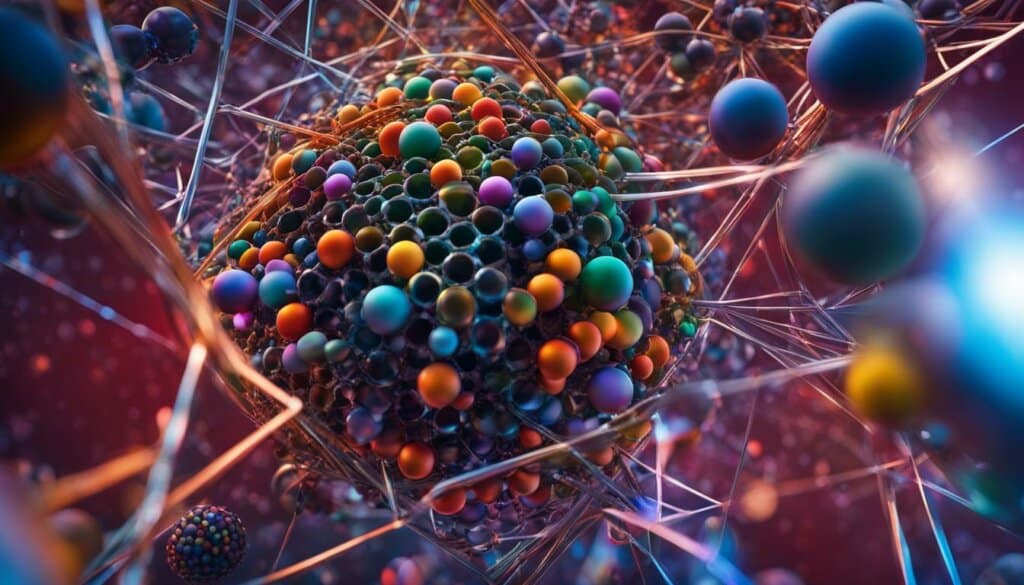Table of Contents
Nature Nanotechnology is a scholarly journal dedicated to publishing research in the field of Physics and Astronomy. It covers all areas of nanoscience and nanotechnology, including the design, characterization, and production of structures and devices at the atomic and molecular scale. The journal is published by Nature Publishing and has an ISSN of 1748-3387. It is indexed in PubMed, Scopus, and Web of Science, and has an impact factor of 39.9 in 2023.
Key Takeaways:
- Nature Nanotechnology is a prestigious journal in the field of nanoscience and nanotechnology.
- The journal covers all areas of nanoscience and nanotechnology, including design, characterization, and production of structures and devices at the atomic and molecular scale.
- Published by Nature Publishing, Nature Nanotechnology has an ISSN of 1748-3387.
- The journal is indexed in PubMed, Scopus, and Web of Science.
- In 2023, Nature Nanotechnology has an impact factor of 39.9.
Nature Nanotechnology Aim and Scope
Nature Nanotechnology is an interdisciplinary journal that serves as a platform for publishing high-quality and significant research in the fields of nanoscience and nanotechnology. The journal aims to advance scientific knowledge and understanding in these areas by facilitating the exchange of ideas and discoveries among researchers from various disciplines.
Nanoscience focuses on the manipulation and control of materials and phenomena at the atomic, molecular, and macromolecular scales. It involves studying the unique properties and behaviors exhibited by matter at the nanoscale, which differ from those observed in bulk materials.
Nanotechnology, on the other hand, deals with the application of nanoscience principles and techniques for the development of innovative devices, materials, and technologies. It encompasses diverse fields such as electronics, materials science, medicine, energy, and environmental science.
Nature Nanotechnology encourages multidisciplinary collaborations and welcomes submissions from researchers across various domains, including chemistry, physics, biology, material science, biomedical research, and engineering. By fostering interdisciplinarity, the journal aims to drive innovation and facilitate breakthroughs in nanoscience and nanotechnology.
The journal encompasses a wide range of research topics, including but not limited to:
- Nanomaterials synthesis and characterization
- Nanofabrication techniques and tools
- Nanodevices and their applications
- Nanomedicine and drug delivery systems
- Nanoelectronics and nanophotonics
- Nanomaterials for energy applications
Moreover, Nature Nanotechnology covers both basic research, investigating fundamental phenomena and processes at the nanoscale, and applied research that leads to the development of practical technologies for industry and society.
Nature Nanotechnology Abbreviation and Ranking
In the field of nanoscience and nanotechnology, Nature Nanotechnology is widely recognized and esteemed. One important aspect of this journal is its abbreviation, which is Nat Nanotechnol. The use of this abbreviation allows for easy reference and recognition in academic discussions and citations.
Additionally, Nature Nanotechnology has achieved an impressive ranking of 43 in 2023. This ranking serves as a testament to the journal’s exceptional quality, influence, and impact within the scientific community. Researchers and scholars in the field can rely on Nature Nanotechnology as a reputable and prestigious source for cutting-edge discoveries and advancements.
With its abbreviation, Nat Nanotechnol, and high-ranking position, Nature Nanotechnology continues to be a prominent and authoritative journal in the field of nanoscience and nanotechnology.

Nature Nanotechnology Impact Factor and Indexing
The impact factor is an important metric that measures the influence and significance of a scientific journal within its field. For Nature Nanotechnology, the impact factor in 2023 is an impressive 39.9. This indicates the high quality and relevance of the articles published in the journal, as well as the degree to which they are cited by other researchers.
The impact factor is calculated based on how many times articles from a specific journal are cited in other publications during a two-year period. A higher impact factor suggests that the research published in the journal has a significant impact on the scientific community and contributes to the advancement of knowledge in the field of nanoscience and nanotechnology.
In addition to its impressive impact factor, Nature Nanotechnology is indexed in several prestigious databases, ensuring its broad visibility and accessibility to researchers, scholars, and readers. The journal is indexed in PubMed, Scopus, Web of Science, UGC, Embase, and DOAJ, among others. This extensive indexing makes it easy for researchers to find and access articles published in Nature Nanotechnology, facilitating the dissemination and impact of the research.
Nature Nanotechnology Editorial Board and Submission Fee
The editorial board of Nature Nanotechnology, led by Editor-in-Chief Alberto Moscatelli, plays a crucial role in ensuring the quality and integrity of the journal’s publications. The board consists of esteemed experts and researchers in the field of nanoscience and nanotechnology who bring their expertise and knowledge to the selection and evaluation process of submitted manuscripts.
“The editorial board of Nature Nanotechnology is dedicated to maintaining the journal’s high standards and upholding its reputation as a leading publication in the field. We strive to identify groundbreaking research and provide a platform for the dissemination of innovative ideas and discoveries.” – Alberto Moscatelli, Editor-in-Chief, Nature Nanotechnology
Authors who wish to submit their research papers or articles to Nature Nanotechnology are required to pay a submission/processing fee known as the article processing charge (APC). The current fee for submission and publication is 11,690 USD. This fee contributes to the costs involved in the peer-review process, editorial evaluation, copyediting, typesetting, and the overall publication process.
It is important to note that the submission/processing fee does not guarantee acceptance of the manuscript for publication. All submitted papers undergo a rigorous peer-review process to assess their scientific rigor, significance, and alignment with the journal’s aims and scope. Authors should ensure that their research meets the high standards set by Nature Nanotechnology before submitting their work.
By charging a submission/processing fee, Nature Nanotechnology can continue to maintain its position as a reputable and influential journal in the field of nanoscience and nanotechnology. The fee also helps support the availability of the journal’s content to the global research community, ensuring broad access to cutting-edge scientific research and advancements.
To learn more about the submission guidelines and process for Nature Nanotechnology, authors can visit the journal’s official website for detailed instructions and requirements.
Nature Nanotechnology Call for Papers
Nature Nanotechnology is currently accepting original research contributions for publication consideration in the field of Physics and Astronomy. If you have conducted groundbreaking research or have significant findings in nanoscience and nanotechnology, we invite you to submit your work to our esteemed journal.
As an interdisciplinary journal, Nature Nanotechnology welcomes submissions that align with our focus on the manipulation and control of materials and phenomena at the atomic, molecular, and macromolecular scales. We encourage researchers from various disciplines, including chemistry, physics, material science, biomedical research, and engineering, to contribute their expertise and insights to our publication.
If you would like to be part of the exceptional research community in the field, this is your opportunity to showcase your work on a global platform. Published papers in Nature Nanotechnology have the potential to influence and shape the future of nanoscience and nanotechnology.
To learn more about our call for papers and submission guidelines, please visit the official website of Nature Nanotechnology. Our website provides detailed information on manuscript preparation, submission process, and other important aspects that will help you navigate the publication process seamlessly.
“Nature Nanotechnology offers a prestigious platform for researchers to share their groundbreaking findings and contribute to the advancement of nanoscience and nanotechnology.” – Alberto Moscatelli, Editor-in-Chief, Nature Nanotechnology

Why submit to Nature Nanotechnology?
- Global exposure and readership within the scientific community
- Impactful research published in a renowned journal
- Potential collaborations and networking opportunities
- High standards of peer-review for rigorous evaluation
- Indexed in PubMed, Scopus, Web of Science, UGC, Embase, and DOAJ
Don’t miss this opportunity to contribute to the field of nanoscience and nanotechnology. Submit your research to Nature Nanotechnology today and be a part of cutting-edge advancements in the field.
Publishing in Nature Nanotechnology
Publishing in Nature Nanotechnology involves conducting high-quality research in the field of Physics and Astronomy, familiarizing yourself with the journal’s aims and scope, and preparing your manuscript according to the journal’s guidelines. Manuscripts should be submitted through the journal’s online submission system.
To ensure your research meets the standards of Nature Nanotechnology, it is essential to conduct rigorous and innovative experiments in the realm of nanoscience and nanotechnology. The journal seeks groundbreaking studies that contribute to the advancement of knowledge in these fields.
“Publishing high-quality research in Nature Nanotechnology not only establishes your credibility as a scientific researcher but also enables your work to reach a wider audience of experts in the field.”
When preparing your manuscript, it is crucial to carefully follow the journal’s guidelines. These guidelines provide information on the structure and formatting requirements, as well as details on the citation style to be used. Adhering to these guidelines will enhance the readability and consistency of your manuscript.
Before submitting your manuscript, it is advisable to review the journal’s aims and scope to ensure that your research aligns with the topics covered by Nature Nanotechnology.
Once your manuscript is prepared, you can submit it through the journal’s online submission system. This system allows for efficient and streamlined manuscript handling, ensuring a smooth review process.
Table 1: Key Steps in Publishing in Nature Nanotechnology
| Step | Description |
|---|---|
| 1 | Conduct high-quality research in the field of Physics and Astronomy. |
| 2 | Familiarize yourself with the aims and scope of Nature Nanotechnology. |
| 3 | Prepare your manuscript according to the journal’s guidelines. |
| 4 | Submit your manuscript through the online submission system. |
| 5 | Await the journal’s decision after the review process. |
| 6 | Revise and resubmit if necessary, addressing reviewer comments. |
| 7 | Celebrate the publication of your research in Nature Nanotechnology! |
Image 1: Nature Nanotechnology Manuscript Preparation
Following these steps will maximize your chances of publishing your research in Nature Nanotechnology and contribute to the advancement of nanoscience and nanotechnology knowledge.
Impactful Nanotech Research Stories
Nature Nanotechnology aims to showcase real-world, impactful research snippets in the field of nanoscience and nanotechnology. The journal strives to highlight success stories that have led to technological breakthroughs, improvements in people’s lives, and contributions to societal development goals.
One impactful nanotech research story revolves around advancements in energy storage. Researchers have developed nanomaterials and nanodevices that greatly enhance the efficiency and capacity of batteries and fuel cells. These advancements have the potential to revolutionize renewable energy sources, making them more efficient and viable for widespread adoption.

Another impactful area of research is targeted gene delivery for medical treatments. Nanoscale delivery vehicles, such as nanoparticles and nanocarriers, are being developed to safely and effectively deliver therapeutic genes to specific cells or tissues in the body. This technology holds promise for treating genetic disorders, cancer, and other diseases at a molecular level, offering new avenues for personalized medicine.
In nanotechnology, we have the power to manipulate and control matter at the atomic and molecular scale. This opens up endless possibilities for technological advancements and applications that can address pressing societal challenges.
Furthermore, the development of high-performance memory devices has been a significant area of nanotech research. Nanoscale materials and structures, such as carbon nanotubes and graphene, are being explored for their potential in creating faster, more efficient, and higher-capacity memory devices. These advancements can lead to improved computing power and data storage capabilities, enabling new frontiers in technology and innovation.
- Advancements in energy storage
- Targeted gene delivery for medical treatments
- Development of high-performance memory devices
These examples demonstrate the immense impact that nanotech research can have on various sectors and highlight the importance of continued exploration and innovation in this field. Nature Nanotechnology is committed to publishing these impactful stories and promoting further advancements in nanoscience and nanotechnology.
Nature Nanotechnology Peer Review
Nature Nanotechnology employs a stringent peer-review process to ensure the quality and integrity of published research. The peer review is a crucial step that helps maintain the journal’s high standards and credibility within the scientific community.
- Submission: When a manuscript is submitted to Nature Nanotechnology, it undergoes an initial review by the editorial staff. They assess its suitability for publication and whether it aligns with the journal’s aims and scope.
- Formal Review: If the manuscript passes the initial screening process, it is then sent for formal review to two or three external reviewers who are experts in the field. These reviewers carefully evaluate the manuscript’s scientific rigor, validity, originality, significance, and methodology.
- Feedback and Recommendations: The reviewers provide feedback and recommendations to the editors. They highlight the strengths and weaknesses of the manuscript, offering constructive criticism and suggestions for improvement.
- Editorial Decision: The editors consider the reviewers’ advice and make an informed decision on the manuscript. They assess the overall quality of the research, taking into account the reviewers’ feedback and the manuscript’s alignment with the journal’s standards.
Peer reviewers play a critical role in maintaining the rigour and validity of the publication process. Their expertise and insights help ensure that only high-quality, groundbreaking research is published in Nature Nanotechnology. By upholding the principles of peer review, the journal fosters scientific excellence and advances the field of nanoscience and nanotechnology.
For a visual representation of the Nature Nanotechnology peer-review process, refer to the following diagram:
| Nature Nanotechnology Peer Review Process |
|---|
Conclusion
In conclusion, Nature Nanotechnology is a prestigious journal that plays a vital role in the field of nanoscience and nanotechnology. With its high impact factor and commitment to publishing high-quality research, the journal provides a platform for scientists and researchers to showcase their significant contributions. The wide range of topics covered and the encouragement of interdisciplinary collaboration make Nature Nanotechnology an invaluable resource for those working in this rapidly evolving field.
Researchers looking to share their work and contribute to the advancement of nanotechnology can submit their manuscripts to Nature Nanotechnology, adhering to the journal’s submission guidelines. By following these guidelines, authors can ensure their research receives the proper consideration and has the potential to reach a global audience of experts in the field.
Overall, Nature Nanotechnology continues to pave the way for groundbreaking discoveries and innovations in nanoscience. Through its rigorous peer-review process and emphasis on quality research, the journal remains at the forefront of scientific advancement and contributes to the progress of nanotechnology on a global scale.
FAQ
What is Nature Nanotechnology?
Nature Nanotechnology is a scholarly journal dedicated to publishing research in the field of Physics and Astronomy. It covers all areas of nanoscience and nanotechnology, including the design, characterization, and production of structures and devices at the atomic and molecular scale.
What is the impact factor of Nature Nanotechnology?
The impact factor of Nature Nanotechnology in 2023 is 39.9. The impact factor is a measure of how many times a particular citation has been published in the past two years.
What is the abbreviation for Nature Nanotechnology?
The abbreviation for Nature Nanotechnology is Nat Nanotechnol.
What is the ranking of Nature Nanotechnology?
In 2023, Nature Nanotechnology is ranked 43, indicating its quality, influence, and prestige within the field of nanoscience and nanotechnology.
Is Nature Nanotechnology indexed in any databases?
Yes, Nature Nanotechnology is indexed in PubMed, Scopus, Web of Science, UGC, Embase, and DOAJ, making it easily discoverable and accessible to researchers, scholars, and readers.
Who is the Editor-in-Chief of Nature Nanotechnology?
The Editor-in-Chief of Nature Nanotechnology is Alberto Moscatelli.
How much is the submission/processing fee for Nature Nanotechnology?
The submission/processing fee (APC) for Nature Nanotechnology is 11,690 USD, which is charged to authors for submitting and publishing their research papers/articles.
Does Nature Nanotechnology have a call for papers?
Yes, Nature Nanotechnology invites original research contributions for publication consideration. Authors can find details about the call for papers on the official website of the journal.
How can I publish in Nature Nanotechnology?
Publishing in Nature Nanotechnology involves conducting high-quality research in the field of Physics and Astronomy, familiarizing yourself with the journal’s aims and scope, and preparing your manuscript according to the journal’s guidelines. Manuscripts should be submitted through the journal’s online submission system.
What kind of research stories does Nature Nanotechnology highlight?
Nature Nanotechnology aims to showcase real-world, impactful research snippets. The journal wants to highlight success stories in nanoscience and nanotechnology that have led to technological breakthroughs, improvements in people’s lives, and contributions to societal development goals.
How does the peer review process work for Nature Nanotechnology?
Nature Nanotechnology follows a rigorous peer-review process. Submitted manuscripts are reviewed by the editorial staff and sent for formal review to two or three reviewers, who provide feedback and recommendations. The editors make decisions based on the reviewers’ advice, taking into account the strengths and weaknesses of the manuscript.













